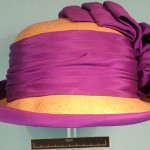Inspired by the theme of this project Penny Boxall wrote this wonderful poem. I hope we hear more from her through the course of the project.
Unpacking my Grandfather by Penny Boxall
The jackets – all but his best – the slacks
and braces were displaced, one way
and another. The shirts were immaterial.
We used the old shot tweed
for lagging, a waxed coat for a play –
it stood for something we could name,
a useful byword anyone could catch.
The semaphore of his ties was sunk
with him, though the waders stand
absurdly upright, jammed with husks,
animals hedging their bets at the first frost.
The brogues are under a fence of coats, paired
in two ready steps. Above them
his hat hangs like an afterthought,
as if he’s wandered through the open
doors into the half-lit film of evening
and will be back for it, given time.
It’s shaped to him, stained with a forgotten
weight of rain and curdled smoke.
Of all his things this is the last,
when even the shoes have broken
their step, upped and left. Even on
the hook it is firm, it is full to the brim.


